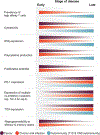Not-so-opposite ends of the spectrum: CD8+ T cell dysfunction across chronic infection, cancer and autoimmunity
- PMID: 34140679
- PMCID: PMC9197228
- DOI: 10.1038/s41590-021-00949-7
Not-so-opposite ends of the spectrum: CD8+ T cell dysfunction across chronic infection, cancer and autoimmunity
Abstract
CD8+ T cells are critical mediators of cytotoxic effector function in infection, cancer and autoimmunity. In cancer and chronic viral infection, CD8+ T cells undergo a progressive loss of cytokine production and cytotoxicity, a state termed T cell exhaustion. In autoimmunity, autoreactive CD8+ T cells retain the capacity to effectively mediate the destruction of host tissues. Although the clinical outcome differs in each context, CD8+ T cells are chronically exposed to antigen in all three. These chronically stimulated CD8+ T cells share some common phenotypic features, as well as transcriptional and epigenetic programming, across disease contexts. A better understanding of these CD8+ T cell states may reveal novel strategies to augment clearance of chronic viral infection and cancer and to mitigate self-reactivity leading to tissue damage in autoimmunity.
Conflict of interest statement
Competing interests
A.H.S. has patents/pending royalties on the PD-1 pathway from Roche and Novartis. A.H.S. is on advisory boards for Surface Oncology, Elstar, SQZ Biotechnologies, Elpiscience, Selecta, Bicara and Monopteros, GlaxoSmithKline and Janssen, and consults for Novartis. A.H.S. has received research funding from Novartis, Roche, UCB, Ipsen, Quark, Merck and AbbVie unrelated to this project.
Figures


References
-
- Liblau RS, Wong FS, Mars LT & Santamaria P Autoreactive CD8 T cells in organ-specific autoimmunity: emerging targets for therapeutic intervention. Immunity 17, 1–6 (2002). - PubMed
Publication types
MeSH terms
Substances
Grants and funding
LinkOut - more resources
Full Text Sources
Other Literature Sources
Medical
Research Materials

